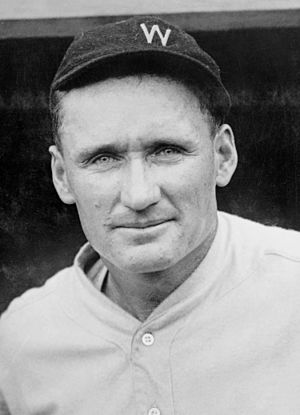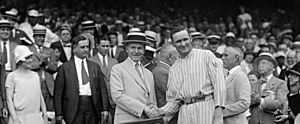Walter Johnson facts for kids
Quick facts for kids Walter Johnson |
|||
|---|---|---|---|

Johnson with the Washington Senators in 1924
|
|||
| Pitcher | |||
| Born: November 6, 1887 Humboldt, Kansas, U.S. |
|||
| Died: December 10, 1946 (aged 59) Washington, D.C., U.S. |
|||
|
|||
| debut | |||
| August 2, 1907, for the Washington Senators | |||
| Last appearance | |||
| September 30, 1927, for the Washington Senators | |||
| MLB statistics | |||
| Win–loss record | 417–279 | ||
| Earned run average | 2.17 | ||
| Strikeouts | 3,508 | ||
| Shutouts | 110 | ||
| Managerial record | 529–432 | ||
| Winning % | .550 | ||
| Teams | |||
As player
As manager
|
|||
| Career highlights and awards | |||
|
|||
| Induction | 1936 | ||
| Vote | 83.63% (first ballot) | ||
Walter Perry Johnson (born November 6, 1887 – died December 10, 1946) was a famous American baseball player and manager. People knew him by his nicknames "Barney" and "The Big Train". He played his entire 21-year career as a right-handed pitcher for the Washington Senators. He played from 1907 to 1927.
After his playing days, Walter Johnson also managed the Senators from 1929 to 1932. He then managed the Cleveland Indians from 1933 to 1935. Many baseball fans consider him one of the greatest pitchers ever. He set many records, and some of them are still unbroken today.
Johnson holds the record for the most career shutouts with 110. He is second in all-time wins with 417. He also ranks fourth in complete games with 531. For nearly 56 years, he held the record for career strikeouts with 3,508. Three players finally passed his strikeout record in 1983.
In 1936, Walter Johnson was one of the first five players chosen for the Baseball Hall of Fame. He was known for being kind and a good sport. His name is still used today to describe fair play in sports.
Contents
Early Life & Baseball Beginnings
Walter Johnson was born on a farm near Humboldt, Kansas. He was the second of six children. His family moved to Orange County, California in 1902 when he was 14. They settled in a small oil town called Olinda.
When he was young, Johnson played baseball and worked in oil fields. He also enjoyed riding horses. He went to Fullerton Union High School. In one game, he struck out 27 batters over 15 innings! Later, he moved to Idaho. There, he worked for a telephone company and pitched for a local team.
A talent scout noticed Johnson in Idaho. In July 1907, at just 19 years old, he signed a contract with the Washington Senators. This was the start of his amazing professional career.
Playing Career Highlights
Walter Johnson was famous for his incredibly fast fastball. People called him the "premier power pitcher" of his time. In 1917, a lab measured his fastball at 91 miles per hour. This speed was likely unmatched back then.
Johnson threw with a sidearm motion. This made his pitches very hard for right-handed batters to hit. The ball seemed to come from an unexpected angle. He also had a good curveball that he started using around 1913.
Johnson's powerful fastball led to his many strikeouts. His record of 3,508 strikeouts stood for over 55 years. Only a few pitchers have passed it since. Compared to other pitchers from his time, Johnson had far more strikeouts.
As a pitcher for the Washington Senators, Walter Johnson won 417 games. This is the second-highest number of wins for any pitcher in history. Only Cy Young won more games (511). Johnson and Young are the only two pitchers to win over 400 games.
During his 21-year career, Johnson had twelve seasons where he won 20 or more games. Ten of these were in a row! Twice, he won over 30 games: 33 wins in 1912 and 36 wins in 1913. He also holds the record for the most shutouts in baseball history with 110.
Johnson won the "Triple Crown" for pitchers three times (1913, 1918, and 1924). This means he led the league in wins, strikeouts, and earned run average (ERA) in those years. He also won the American League Most Valuable Player Award twice (1913, 1924).
In 1913, his ERA was an amazing 1.14. This is still the sixth-lowest ERA ever for a pitcher who pitched many innings. From 1910 to 1919, Johnson averaged 26 wins each season. His overall ERA during that decade was a tiny 1.59.
In April and May of 1913, he pitched 55.2 innings in a row without giving up a run. This is still an American League record. In May 1918, he had another streak of 40 scoreless innings. He is the only pitcher with two such long streaks.
Even though he often played for teams that didn't win much, Johnson finally led the Washington Senators to the World Series in 1924. This was his 18th year in the league. He lost the first and fifth games of the series. But he became a hero in the seventh and final game. He pitched four scoreless innings in relief, helping his team win in the 12th inning.
The Senators went back to the World Series in 1925. Johnson won two early games, but his team lost the deciding Game 7. On October 15, 1927, Johnson officially retired from playing.

Johnson was also a good hitter for a pitcher. He had a career batting average of .235. In 1925, he hit an amazing .433! His 547 career hits are the most by any full-time pitcher. He even played in the outfield 13 times. He hit 24 home runs in his career, which is one of the highest totals for a pitcher.
Walter Johnson was known for being a very kind person. He made many friends in baseball. He was even friendly with Babe Ruth, even though Ruth hit some of his longest home runs off him!
Managerial Career
In 1928, Walter Johnson started managing in the minor leagues. He managed the Newark Bears. Then he moved to the major leagues. He managed the Washington Senators from 1929 to 1932. After that, he managed the Cleveland Indians from 1933 to 1935.
His managing record was 529 wins and 432 losses. His best team was in 1930, when the Senators finished with 94 wins. He had five winning seasons as a manager.
Baseball Hall of Fame
Walter Johnson was one of the first five players ever chosen for the Baseball Hall of Fame in 1936. The other "first five" were Ty Cobb, Christy Mathewson, Babe Ruth, and Honus Wagner. They were known as the "Five Immortals" because they were the first to be honored in this way.
Life After Baseball & Politics
After retiring from baseball, Walter Johnson lived in Germantown, Maryland. In 1936, he gained national attention. He threw a silver dollar across the Rappahannock River. This was a famous feat that people said George Washington once did. Johnson proved it was possible!
Johnson was a Republican and a friend of President Calvin Coolidge. In 1938, he was elected as a commissioner for Montgomery County, Maryland. In 1940, he ran for a seat in the U.S. House of Representatives but did not win.
Walter Johnson married Hazel Lee Roberts in 1914. They had five children. Sadly, his oldest daughter died from influenza in 1921. His wife passed away in 1930. Walter Johnson died on December 10, 1946, at age 59, from a brain tumor. He is buried in Rockville, Maryland.
Legacy & Recognition
Walter Johnson is remembered in many ways:
- Walter Johnson High School in Bethesda, Maryland, is named after him. The school's yearbook is called The Windup, and its newspaper is The Pitch.
- A baseball field in Rockville, Maryland, is named for him.
- A large park in Coffeyville, Kansas, is called Walter Johnson Park.
- The Bethesda Big Train, a summer baseball team, is named in his honor.
- The baseball field in Memorial Park in Weiser, Idaho, is called Walter Johnson Field.
- In 2009, a statue of Johnson was placed inside Nationals Park, the home stadium of the Washington Nationals.
- There is a Walter Johnson Road in Germantown, Maryland.
Nicknames & Sportsmanship
Besides "Barney" and "The Big Train," he was also called "Sir Walter" and "The Gentle Johnson." These names showed his kind and gentlemanly sportsmanship. His gentle nature was legendary. He is still seen as an example of good sportsmanship and friendly competition.
In 1999, The Sporting News ranked Johnson as the 4th greatest baseball player ever. He was the highest-ranked pitcher on the list. Later that year, he was chosen for the Major League Baseball All-Century Team.
In 2015, he was named one of the "Greatest Pioneers Group" in baseball. Fans voted for him as one of the most impactful players in history.
Career Statistics
Here are some of Walter Johnson's career statistics:
Pitching
| W | L | WP | GP | GS | CG | Sh | SV | IP | H | HR | BB | SO | HBP | BFP | ERA | WHIP |
| 417 | 279 | .599 | 802 | 666 | 531 | 110 | 34 | 5,914.1 | 4,913 | 97 | 1,363 | 3,508 | 203 | 23,749 | 2.17 | 1.061 |
Hitting
| G | AB | H | 2B | 3B | HR | R | RBI | SB | BB | SO | AVG | OBP | SLG | OPS |
| 933 | 2,324 | 547 | 94 | 41 | 24 | 241 | 255 | 13 | 110 | 251 * | .235 | .274 | .342 | 0.616 |
* Strikeouts were not officially counted for batters until 1913 in the American League.
See also
 In Spanish: Walter Johnson para niños
In Spanish: Walter Johnson para niños
- 300 win club
- 3,000 strikeout club
- List of Major League Baseball career wins leaders
- List of Major League Baseball annual ERA leaders
- List of Major League Baseball no-hitters
- List of Major League Baseball annual strikeout leaders
- List of Major League Baseball annual wins leaders
- List of Major League Baseball all-time leaders in home runs by pitchers
- List of Major League Baseball players who spent their entire career with one franchise
Images for kids



